|
|
|
Sort Order |
|
|
|
Items / Page
|
|
|
|
|
|
|
| Srl | Item |
| 1 |
ID:
192976
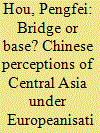

|
|
|
|
|
| Summary/Abstract |
The article examines how China perceives Central Asia under Europeanisation after the Cold War (1992-2022). Central Asia is a geo-economically significant frontier zone between China and the European Union (EU). The EU released the Central Asia strategies in 2007 and 2019. Although there were no immediate policy reactions from neighbouring China, we can sketch China’s seemingly paradoxical perceptions of the region by scrutinising official narratives. The perceptions have been simplified into the bridge-base dyad. As a land bridge, Central Asia connects China with the EU, the role of which gained growing significance against the backdrop of the Russia-Ukraine conflict. As a possible ideological base, Central Asia, under Europeanisation, may spread incompatible norms to the contiguous Xinjiang. Wary of creeping foreign hostile forces, China particularly underlines Xinjiang’s stability.
|
|
|
|
|
|
|
|
|
|
|
|
|
|
|
|
| 2 |
ID:
192975
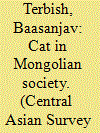

|
|
|
|
|
| Summary/Abstract |
In Mongolia the cat is viewed ambiguously. It is seen either as a good, a bad or an ugly creature, or as a mix of all these. This ambiguity stems from the cat’s function as a mirror of Mongolian society, where the transition to socialism and post-socialism was traumatic, interrupting the cosmological order. This paper explains these diverse images by analysing old legends and modern folk stories about felines.
|
|
|
|
|
|
|
|
|
|
|
|
|
|
|
|
| 3 |
ID:
192974


|
|
|
|
|
| Summary/Abstract |
Against the prediction of developmental orthodoxy that urbanization is a necessary condition for economic development, since the mid-1990s Georgia and Armenia achieved sustained economic development without rural–urban migration. The experience of Georgia and Armenia is placed in the context of the relation between urbanization and development in other countries of Central Asia. This is followed by an in-depth analysis of Georgia, which shows that when the home consumption of rural smallholders is included in rural incomes, and when the increase in the urban cost-of-living relative to the rural cost-of-living is taken into consideration, the incentive to migrate from the countryside to the towns is greatly weakened.
|
|
|
|
|
|
|
|
|
|
|
|
|
|
|
|
| 4 |
ID:
192969
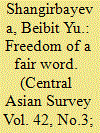

|
|
|
|
|
| Summary/Abstract |
This article examines the roots of freedom of expression and opinion, of the right to a fair trial, and of the freedom to enjoy cultural rights in Kazakh nomadic customary traditions that underlie and give meaning to human rights discourse in contemporary Kazakh society. Based on oral traditions and the perception of fairness of the nomadic Kazakhs, this rich heritage created resilient instruments that are still vital and play a significant role in the judiciary, political discussions, public debates and cultural performances in contemporary Kazakhstan. The evidence indicates that in Kazakh nomadic society a core essence of these freedoms was ‘the freedom of a fair word’, which, combined with outstanding rhetorical skills, functioned as an instrument through which civil, political and cultural rights were ensured; the concept enacted a discourse of commentary and claims-making analogous to norms of human rights. This research provides evidence for how ‘the freedom of a fair word’ was articulated by the general population in the traditional nomadic institutions of the bi, and of the zhyraus and aqyns.
|
|
|
|
|
|
|
|
|
|
|
|
|
|
|
|
| 5 |
ID:
192972
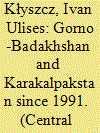

|
|
|
|
|
| Summary/Abstract |
The two Central Asian autonomies of Gorno-Badakhshan and Karakalpakstan have functionally the same competencies as other regions in their respective countries. And yet their autonomous status has persisted. Why? What functions does territorial autonomy carry out in authoritarian states? This paper argues – on the basis of Akchurina’s work of 2019 – that territorial autonomy in Central Asia is a feature of the incomplete state. Namely, territorial autonomy is an institution that sustains informal processes through which state authority is exerted in these challenging territories. The article substantiates this argument by tracing the evolution of centre–region relations in Gorno-Badakhshan and Karakalpakstan since 1991. For Dushanbe, territorial autonomy is a way to symbolically outsource its authority to rebellious local elites, while in Karakalpakstan autonomy allows Tashkent to manage the latent independence claims of the Karakalpaks.
|
|
|
|
|
|
|
|
|
|
|
|
|
|
|
|
| 6 |
ID:
192971


|
|
|
|
|
| Summary/Abstract |
In this article we will consider the language policy the Soviet authorities directed toward the Bukharan Jews in Uzbekistan. These reforms were carried out in several stages. Initially, traditional Hebrew education was banned in favour of the Judeo-Tajik language. Then, in the late 1930s, it was the turn of the ban in favour of the Russian, Tajik and Uzbek languages. At the same time, the national schools of the Bukharan Jews were liquidated. All this, as well as the alphabet of education, changed twice in the 1930s, harmed the level of education of Bukharan Jews. As a result, many Bukharan–Jewish children could not handle the language innovations and began to study worse or even stopped attending public schools. Concerned about this, the authorities were forced to temporarily restore Bukharan–Jewish schools and classes with Judeo-Tajik or Tajik language instruction in the mid-1940s. This history shows that the Soviet authorities carefully monitored the reaction of the population and were able to show flexibility in matters that were not points of principle.
|
|
|
|
|
|
|
|
|
|
|
|
|
|
|
|
| 7 |
ID:
192977
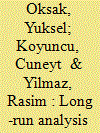

|
|
|
|
|
| Summary/Abstract |
Using an unbalanced data set covering the years from 1990 to 2017, this study examines the long-run relationship between three selected macroeconomic variables (unemployment, per capita gross domestic product (GDP) and inflation) and suicide rates for Turkic-speaking countries in Central Asia and the South Caucasus (Azerbaijan, Kazakhstan, Kyrgyzstan, Turkmenistan and Uzbekistan). The mean group estimation results suggest that among the three macroeconomic variables under study, only the unemployment rate has a statistically significant relationship with the suicide rate for the Central Asian Turkic-speaking countries. Regarding country-specific estimations, results suggest that all macroeconomic variables under study correlate with the suicide rate for some countries in the sample. Overall, the empirical findings of the study suggest that unemployment and per capita GDP are important contributors of suicide and intentional self-harm in Central Asia. Estimation results also call attention to the inflation rate.
|
|
|
|
|
|
|
|
|
|
|
|
|
|
|
|
| 8 |
ID:
192968


|
|
|
|
|
| Summary/Abstract |
The Sāmānid dynasty of Transoxiana is perhaps best known today for its foundational contributions to the formation of Persianate culture in the ninth and tenth centuries. The problems of the origins of the dynasty has received scholarly attention for many years. However, the field is in some ways still very much dependent upon nineteenth-century ethno-racial categories. This paper critically traces the history of the question, ending with some alternative approaches based on the shifting of economic power in Transoxania from merchants to the agrarian magnates.
|
|
|
|
|
|
|
|
|
|
|
|
|
|
|
|
| 9 |
ID:
192978


|
|
|
|
|
| Summary/Abstract |
This mixed-methods study is the first to explore the association between fee-charging private supplementary tutoring (PT) participation and access to higher education in Kazakhstan from the perspectives of Grade 11 students during the COVID-19 pandemic. Guided by the work of Entrich in 2018, a four-dimensional model of educational inequality in PT, this study found that the scale of PT had expanded during the pandemic, with 75.06% (623 out of 830) of participants engaged in PT, mainly to excel in the university entrance examinations and gain a state grant at their preferred university in Kazakhstan. Also, 73.8% of the students spent 40,000 tenge (US$88) or less on PT per month. Although participants’ families prioritized boys for providing PT services, most participants neither agreed nor disagreed that PT was a financial pressure on their families, probably because the majority attended group tutoring delivered at tutorial centres, and this mode of tutoring reduced the unit cost and gave them the attention they needed from their tutors. The 30 interviewees had positive attitudes towards PT, but some mentioned a few of its disadvantages, including the spread of less qualified, costly tutors due to the unregulated PT market in Kazakhstan. This study suggests pedagogical implications and areas for ongoing research.
|
|
|
|
|
|
|
|
|
|
|
|
|
|
|
|
| 10 |
ID:
192970


|
|
|
|
|
| Summary/Abstract |
The study of language and script change among the Turkic communities of the Soviet Union often focuses on the switch from Arabic to Latin scripts. Less attention is paid to adaptations of the Arabic script to Turkic vernaculars, and to attempts aimed at convincing the literate masses of their usefulness. In the current paper, I aim to do just that. By making use of Turkic-language periodicals from Crimea, Azerbaijan and Uzbekistan, I throw light on the era before Latin. I explore writers’, editors’ and other intellectuals’ efforts to vernacularize written languages and enforce national boundaries along Soviet lines through changes to the dominant script. More than this, I investigate these actors’ use of magazines to convince their readers of new vernacular, language- and territory-based national identities. In doing so, I demonstrate that periodicals became implements of national consciousness creation targeted at the Turkic citizens of the early Soviet Union.
|
|
|
|
|
|
|
|
|
|
|
|
|
|
|
|
| 11 |
ID:
192973
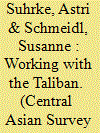

|
|
|
|
|
| Summary/Abstract |
Nearly two years after the Taliban seized power in Kabul, in August 2021, the international aid community continued to search for workable approaches to deal with the new situation. Afghanistan’s deepening economic and humanitarian crisis called for major assistance, but the relationship between major donors and the Taliban de facto authorities had settled into a deeply adversarial mode. It resembled in many respects the relationship between the international aid community and the Taliban during the first Emirate (1996–2001). The story of that limited and difficult interaction – mostly consisting of humanitarian aid in a process that swung between confrontation and creative, though modest, compromises – is worth recalling for the insights it holds for the present. This article examines the patterns of that interaction, the results on the ground and the implications for the Western relationship with the present Taliban Emirate.
|
|
|
|
|
|
|
|
|
|
|
|
|
|
|
|
|
|
|
|
|